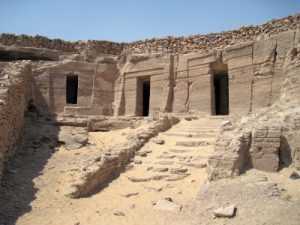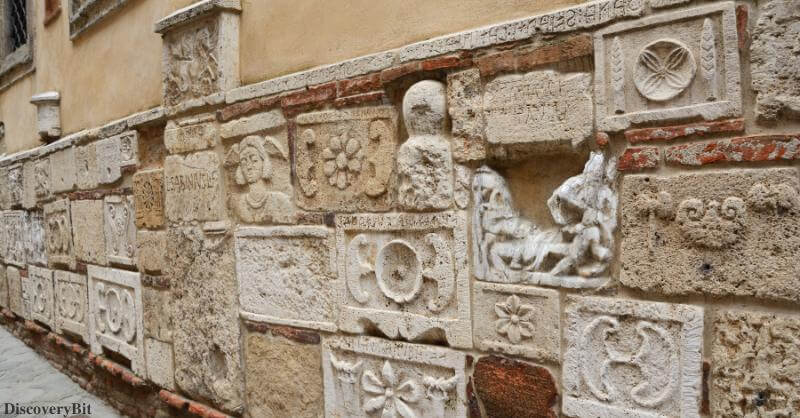9 – Intact Greek Shipwreck
An international group of archeologists has found one of history’s most amazing discoveries.
An intact sunken shipwreck found along known ancient Greek commercial routes, in the black sea, has been found after some 2400 years. The Greek ship, which was located off the coast of present-day Bulgaria, is so well preserved that its mast, oars, and rudders are still attached and even seem functional.
This is truly one of the most amazing discoveries and ancient artifacts that could offer clues into shipbuilding and faring during ancient times.
Another interesting discovery by a team of German archeologists is the discovery of the tomb of Princess Herbertingen.
10 – Tomb of a Legendary Celtic Princess
Near the German town of Heuneburg, a group of archaeologists discovered the burial chamber of a legendary Celtic princess. The cabin, which measures 20 meters square, is located in the center of a large mound that protects it from grave robbers to this day.
In an attempt to extract the chamber, after the first inspections, it was determined that conventional excavation methods would not be used since the chamber was so highly preserved. Therefore, the archeologists, in a marvel of engineering, extracted the entire chamber in one giant block of earth and transported it to a laboratory for proper analysis.
What they found was considered one of the world’s most amazing discoveries. The oak wood of the chamber’s floor was intact and had not suffered any water damage as is so prevalent in underground tombs. Further study determined the tomb dates back to the year 583 BC, which gives the modern world a wholly unique view of the primitive and legendary Celtic world.
The next discovery may broaden your horizon when you discover that the ancient Egyptians were not the only culture that mummified their dead.
11 – Ancient Peruvian Mummy
Many ancient cultures, throughout history, have given great importance to the preservation of their deceased as part of ceremonial funeral customs.
While ancient Egyptian culture is the best-known example of this behavior, they are far from being the only one. One culture that regularly performed these rituals of mummification was the Peruvian Ichma people.
It was, recently, announced that a team of archaeologists from Belgium had discovered an intact Peruvian mummy thought to be more than a thousand years old. Finding mummies is in itself rare, but finding specimens in such a pristine and untouched condition is a once-in-a-lifetime find that can be considered one of the world’s most amazing discoveries.
If you think mummies are fascinating, wait until you hear about the mummified claw that scared archaeologists in New Zealand.
12 – Mummified Mount Owen Moa
Everyone has heard of the Dodo; however, few people are aware of the existence of the majestic Moa. The Moa was a group of species of giant flightless birds, not unlike modern-day ostriches, which were native to New Zealand until their extinction around the year 1300 AD.
However, thirty-eight years ago, in 1986, a group of speleologists who were investigating a vast system of caves in Mount Owen, New Zealand, found a large and practically intact Moa talon. Its appearance (still possessing both muscle and sinew tissues) seemed to indicate that it belonged to a recently deceased animal. Nevertheless, laboratory analysis dated the find to be more than 3000 years old, which completely changed the world’s understanding of the way animal matter could decompose over time, making this one of the most amazing discoveries ever found.
The claw of Mount Owen was discussed around the world because for years many believed it to be the claw of a dinosaur.
Another discovery that is probably commonly heard of around the world is the next item on our list, the tomb of the most famous pharaoh in history.
13 – King Tutankhamun’s Tomb
The British archaeologist Howard Carter discovered the tomb of Tutankhamun in the Valley of Kings on November 4, 1922, near the tomb of Ramses VI.
The site was found under the remains of the homes of the workers of the Ramesside period, and this helped to preserve it. Curiously enough, when Carter entered the chamber, he was able to photograph floral offerings that later disintegrated into dust after 3300 years.
The tomb’s four chambers were filled with objects, so many, in fact, that completely emptying the tomb took over 8 years. More than 5000 pieces, including that pharaoh’s iconic mask, were eventually transported to the Egyptian Museum in Cairo.
King Tut’s tomb is one of the most amazing discoveries and ancient artifacts that renewed worldwide interest in the study of Egyptology and inspired a generation of people to study archeology.
Another important, albeit lesser-known, tomb in Egypt was found deep within the necropolis at Qubbet el-Hawa, and it is the next amazing discovery on our list.
14 – Qubbet el-Hawa Necropolis

Image Credit
Qubbet el-Hawa, which is Arabic for House of the Winds, is also known as the Valley of the Princes. The necropolis at Qubbet el-Hawa is located on a rocky hill on the western bank of the Nile and it served as the burial grounds of the region’s highest dignitaries.
A team of archeologists has recently found an intact mummy, identified as Shemai, which belonged to the brother of a prominent and well-known governor of the island of Elephantine some 3800 years ago. Besides the well-preserved mummy, the discovery is noteworthy as well for the fact that archeologists, for the first time, were able to document the entirety of one of the multiple burial chambers found on the island.
The discovery of Shemai illuminates the genealogy of a lineage that for centuries served as royal emissaries during the military campaigns of the Egyptian Pharaohs.
The next item on the list and perhaps one of the most amazing discoveries in the history of archaeology may well shine a light on the lineage of all mankind!
15 – 7000-Year-Old Brains
It is one thing for an inorganic matter like stone and masonry to survive intact throughout the years, but it is another matter when organic materials do so.
It is extremely rare, although not unheard of, for human remains to stay preserved for hundreds of years. But for human remains to survive, well-preserved, for thousands of years is astonishing and is truly one of the most amazing discoveries.
In 1996, two archeologists digging through the peat bottom of a lake in the state of Florida, USA, found not one, but two intact human brains. The specimens were so well-preserved that they retained their original shape and size, and a laboratory analysis reported that the tissue contained intact DNA.
Archeology can give glimpses into the deep past and may perhaps provide us with the insight to make accurate conjectures about the human future path through history.
Tags: Amazing discoveries Ancient Artifacts Ancient discoveries Archaeology Archeological discoveries Archeology News; Historical Artifacts Discovery












